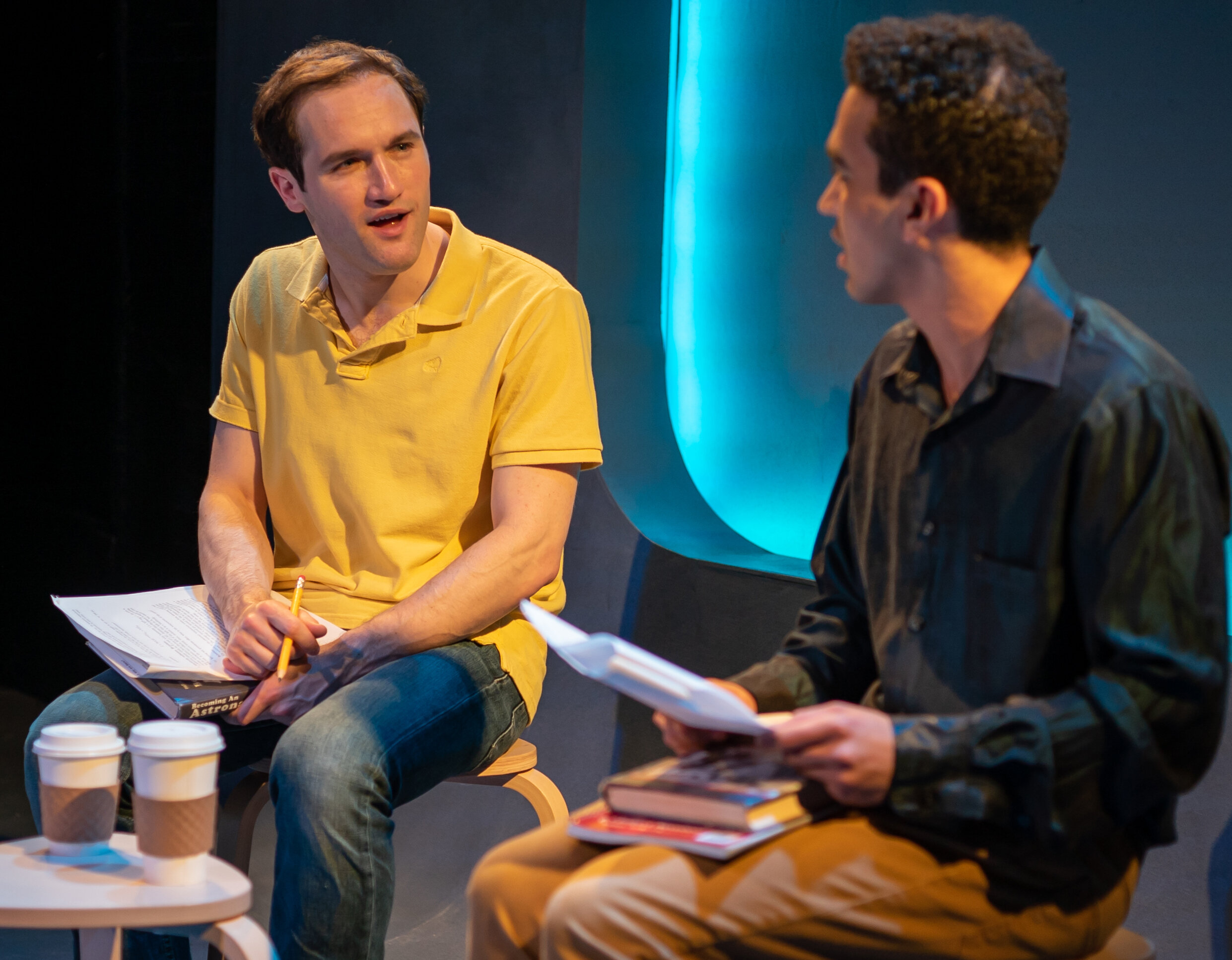Harrison Unger (left) is would-be astronaut Tom, and Tay Bass is his girlfriend Claire in Johnny G. Lloyd’s Or, An Astronaut Play.
The welcoming speech at a Tank production usually stresses the reach of the organization. The audience is typically informed that the Tank produced more than 1,000 productions last year. It’s impossible that all of them would be home runs, of course, and yet even those with modest virtues may be worth noting. Such is the case with Johnny G. Lloyd’s Or, An Astronaut Play, an amusing sketch of a play enhanced by very good performances, as well as the author’s intelligence and sly wit.
Unger and Caturah Brown, as the ambitious Daria, wait for the professor in astronaut school.
The play opens with a cohabiting couple at their computers. Harrison Unger’s Tom is taking an online quiz, with such questions as “What’s your favorite color?” For that one, he asks his partner Claire (Tay Bass), “What’s my favorite color?” It is, Tom explains, a vocational test, and the absurdity of Lloyd’s comedy quickly establishes the tone. Tom asks: “If I had to die in a fire, what floor would I be found on?” Claire thinks the third floor, since that’s the floor they live on. Tom thinks otherwise:
Maybe I’d run out of the apartment once I saw the smoke. Then I’d get down a flight of stairs but I’d be overcome by the fumes and I’d pass out. So really I’d die on the second floor.
“I don’t think you’d do that,” says a skeptical Claire. “That sounds like a lot of—movement.”
Unger’s Tom with Jonathan Cruz’s highly qualified but bizarre space candidate Paul.
After an equally inane numerology question—“What’s my favorite number?”—Tom discovers that the results indicate he should be an astronaut. “Makes sense, in a way,” he observes. “I always liked space movies.”
Scenes change quickly, signaled by saturated colors in six globes used by lighting designer Bailey Costa, sometimes in combination—blue and green—at other times uniform, e.g. cobalt. Somehow skipping over the entire application process, Tom arrives at astronaut school the next day. There he meets Daria, a black woman who, in Caturah Brown’s forceful portrayal, is competent, introspective, smart and energetic. She has known since she was 5 that she wanted to be an astronaut. Tom admits to discovering his destiny much more recently, but notes:
I’ve always liked looking at pictures of planets. Sometimes I like drawing them. And I read this thing, last night, that said you’re an inch taller in space. Which I’ve always wanted to be a little bit... So it seemed like a good fit. After some thought.
Director William Steinberger steers the cast deftly through the loopy scenes, as logic, time, and credibility are thrown overboard, and absurdism holds sway. Daria works in admissions at the astronaut school (and slowly rises to board member), and at her behest, Claire joins classes to become an astronaut. Her analytics background alone makes her a better candidate than Tom, who plugs along, convinced he’d be the best astronaut. In a supremely silly sight gag, he shows up with a piece of homemade equipment.
There’s also a fourth classmate, Paul. “I’m a hobbyist—professionally,” he tells the others. “It’s very difficult, but those of us on the circuit manage.” Jonathan Cruz delivers the drily witty dialogue almost catatonically, and he makes a meal of a scene with a bag of strange objects, including a bonsai cactus, an origami swan, and a square of Play-Doh.
Paul with Claire after she joins the astronaut training. Photographs by Skye Morse-Hodgson.
Holding the center is Unger as Tom, and in addition to embodying the rare combination of leading-man looks and goofiness, Unger conveys both Tom’s disappointment at the turn his personal life takes and the character’s ignorance of his advantages. Lloyd, a young black playwright, avoids the easy portrait of an arrogant white male reeking of privilege, although the play, if it’s about anything, is about that. Tom may possess white male privilege but his misplaced self-confidence is unconnected to any awareness of entitlement. Lloyd shows a welcome subtlety in recognizing that point, and he gives Tom a crucial monologue late in the play that displays sympathy for the character, defeated and alone.
After awhile, though, one wishes that Lloyd were a bit more direct and the structure of his play were tighter. The scenes seem too isolated, and at times lurch from one to another. Even given his deft use of absurdism, the four characters seem unmoored from any reality. Still, Lloyd’s willingness to use comedy as the vehicle for his dramatic gifts is particularly heartening.
Or, An Astronaut Play, runs through Jan. 26 at the Tank (312 W. 36th St. between Eighth and Ninth Avenues). Performances are at 7 p.m. Thursday through Saturday and at 3 p.m. Sunday. For information and tickets, call (212) 563-6269 or visit thetanknyc.org.






